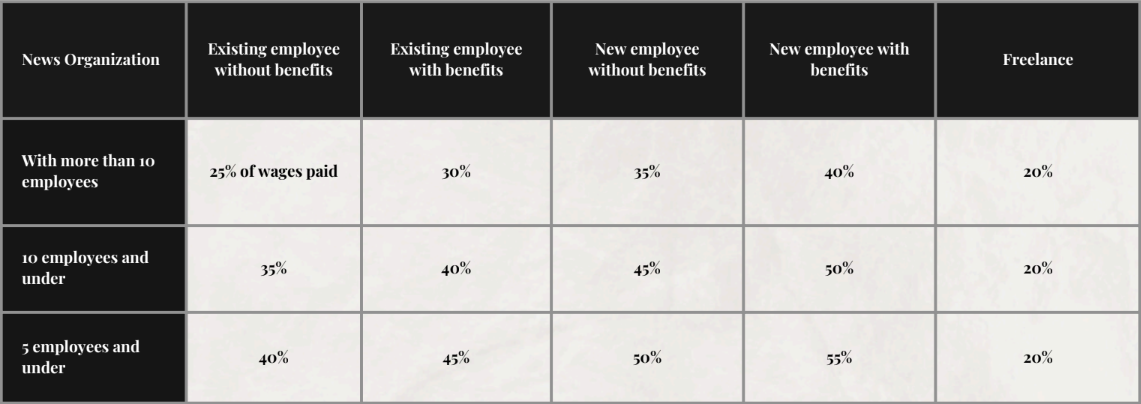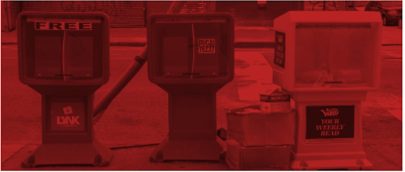The California Legislature’s Local News Push
This resource from Free Press Action and Rebuild Local News analyzes two bills aimed at addressing the decline of local news.
This session of the California state legislature has been marked by an unprecedented surge of interest from lawmakers in addressing the decline of local news. In the span of just over a year, two significant bills have been advanced that aim to divert hundreds of millions of dollars towards journalism: AB 886 and SB 1327.
Both bills aim to redirect revenues from wealthy big tech platforms to support local news – but the approaches they take to get there are wildly different. Both bills are also at a crucial inflection point, with just a matter of weeks left in the legislative session. SB 1327 has passed the Senate and will be taken up by the Assembly in early August. AB 886 has passed the Assembly, cleared its first committee hurdles
in the Senate, and also awaits action in early August.
The last day for the legislature to pass bills and send them to the governor’s office is Aug. 31, which makes this a prime moment to get caught up to speed. This explainer breaks down what’s in the two bills, lays out possible outcomes ahead, and includes some key background context.
What’s in the California Journalism Preservation Act (AB 886)?
The CJPA was first introduced in spring 2023 by Assm. Buffy Wicks, and is partially modeled off the Journalism Competition and Preservation Act, pending federal legislation currently before Congress. The core idea is that platforms like Google and Meta should compensate news publishers for sharing and accessing their content.
This idea has international roots: In Australia, Rupert Murdoch’s News Corp. joined two of its largest competitors in 2021 to push for the passage of a law that forced platforms to negotiate with news outlets if they wanted to share links to their stories. Canada followed suit with similar legislation in 2023.
The CJPA has undergone amendments since it was first introduced, and a revised version was released earlier this summer. You can find a more detailed comparison of what changed in the CJPA here. Below is a breakdown of how the bill would work as currently written.
How would the legislation generate revenue to support local journalism?
-
- In the original version of the CJPA, platforms would be required to compensate all qualifying news outlets based on the number of instances where a platform presents a link to those outlets’ websites.
- In the revised CJPA, platforms have two options. The first option is similar to the original CJPA model – platforms would have to pay qualifying news outlets annually for accessing their content, with the payment value determined by an arbitration process. The other option allows platforms to pay an annual fee (unknown as of yet) into a fund to support California journalism. This is the option that platforms are likely to choose if the CJPA is enacted.
How would the revenue be distributed?
-
- Once the money from platforms is in the fund, it would be distributed to outlets proportionally based on the number of journalists that each newsroom employs. The more journalists that an outlet employs, the more money they would receive. (Journalists are defined as being “employed by each qualifying publication for the primary purpose of producing content for a California audience.”)
- The smallest of outlets – those with fewer than five employees – would be able to claim some of their spend on freelancers as “full time employees” for the purpose of the program.
- One percent of the total fund would be set aside for smaller outlets that would receive less than $25,000 annually under this scheme.
Which outlets would qualify to receive benefits?
-
- The outlets that would be eligible to receive payments from tech platforms include local broadcast news stations and outlets that have “at least 25 percent of its editorial content consisting of information about topics of current local, regional, national, or international public interest.” There is no cap on the size of the outlets that can qualify.
Are there stipulations on how qualifying outlets can spend the money?
-
- Qualifying outlets would need to spend at least 70% of the money received on “news journalists and support staff.” For smaller outlets with five or fewer employees, this requirement would drop down to 50%.
What’s in SB 1327?
SB 1327 was introduced in spring 2024 by Sen. Steve Glazer, in part to address concerns raised by community publishers, digital rights groups, and ethnic media outlets in 2023. After an initial push for passage in the Senate fell short, it was unexpectedly passed with ⅔ support in late June. (SB 1327 requires a higher vote threshold than the CJPA because it creates a new tax.)
How would the legislation generate revenue to support local journalism?
-
- The legislation would impose a “data extraction mitigation fee” — a 7.25% tax on digital advertising revenues originating in California — on major tech platforms. The first $2.5 billion in California revenue that platforms earn from digital advertising is exempt from being taxed.
- This is estimated to generate roughly $500 million annually for local news.
How would the revenue be distributed?
-
- Commercial outlets would receive a refundable tax credit to cover a portion of employees’ wages. The credit scales up for smaller outlets and for journalism employers who provide benefits, and includes coverage for freelance employees. Outlets that hire new employees also receive an increased benefit. The table below shows a full breakdown.

-
- $25 million is set aside annually for nonprofit outlets. Nonprofits would receive grants that are equal to the amount of the credit they would receive per the table above. (Note: Sen. Glazer’s office is evaluating how to right-size the pool of money set aside for nonprofit newsrooms in the state, accounting for growth in the sector.)
- UC Berkeley’s California Local News Fellowship program, which trains and places journalists in underserved communities across the state, would receive $10 million to solidify and expand its program.
- $5 million would be set aside annually to “establish a program to provide fellowships for hiring, training, and career progression for journalists and media professionals from historically underrepresented and marginalized backgrounds.”
Which outlets would qualify to receive benefits?
-
- To qualify, an outlet’s primary purpose must be to serve a local community in the state by providing local news. This includes local broadcast news stations.
- Publications must also be published in the state during the taxable year and the prior taxable year, and be covered by media liability insurance.
- There is no cap on the size of the outlets that can qualify.
Possible Outcomes
There is a short window for both bills to pass, since the legislative session is set to end on Aug. 31. One outcome, of course, is that neither bill passes. But outside of this possibility, there are three main possible outcomes:
-
- Either SB 1327 or AB 886 passes and is sent to the governor’s office. It is highly unlikely that both pass, though in politics anything is possible.
- The bills’ sponsors come together and merge the bills in some form or fashion, and the legislature sends this new bill to the governor’s office.
- Lawmakers reach an agreement with tech platforms. The tech platforms would be exempt from any enacted legislation (or the legislation would be shelved), and in return the platforms would likely contribute funds toward local news in the state, though how exactly this is done remains to be seen. They could offer to reallocate their own tax breaks in support of local news publications, privately contribute to the local news landscape, or put money into a fund that could be distributed to CA outlets in some fashion. In this case, lawmakers would have to figure out a mechanism to distribute the funds to local news outlets in the state, likely drawing inspiration from the distribution mechanisms laid out in SB 1327 and AB 886.
Other Important Context to Know
Both Sen. Glazer and Assm. Wicks have expressed a willingness to amend their bills based on feedback that they receive from stakeholders. Even with a short runway to pass legislation, there’s still an opportunity to implement changes.
Glazer and Wicks have also publicly stated that they support both bills, and that they don’t view them as competitive efforts. One reason for this could be that lawmakers want to apply as much pressure on tech platforms as possible to sit down at the negotiating table and figure out a deal where platforms voluntarily contribute funds to be used for local news support.
We can also turn to Canada for some lessons on how the tension between tech platforms and lawmakers might play out. Canadian lawmakers passed legislation similar to the CJPA in 2023. In response, Google and Meta pulled all news content from their platforms in Canada. Google eventually reached a deal in which it would restore news content and make annual payments into a collective fund for local news. The payments come out to roughly $73 million a year in U.S. dollars, and will be distributed based on newsroom headcount. Meta, however, has continued to block news in Canada on Facebook. Researchers found that the “end of news availability on Facebook has resulted in a significant decrease in engagement for Canadian news outlets, but has not substantially changed the behavior of Canadian Facebook users.”
Separately, Canadian lawmakers also passed a digital services tax in June 2024 that roughly resembles Glazer’s “data extraction mitigation fee,” though the benefits aren’t earmarked for local journalism. The 3% tax will apply to revenue from companies that provide digital services to Canadian users, or sell Canadian user data. No platform is threatening to block links as a result of this legislation. For the last five years, however, Canada has offered news outlets a “labour tax credit” that very closely mirrors Sen. Glazer’s proposed local journalism subsidy in SB 1327. The program has been largely successful in Canada and was recently expanded.
Questions? Anything else you’re curious about when it comes to these local news bills? Looking to get engaged on these bills? Reach out to Anna Brugmann, Policy Director at Rebuild Local News (annabrugmann@rebuildlocalnews.org) and Alex Frandsen, Journalism Program Manager at Free Press Action (afrandsen@freepress.net). We’re happy to keep adding to this doc if there are key points that you’d like to learn more about.






